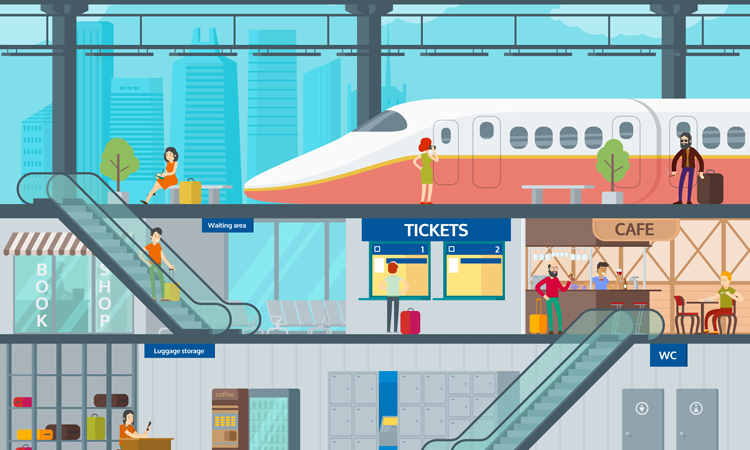Designing the station of today – and tomorrow – with HS2
Posted: 25 March 2019 | Johannah Randall | 2 comments
Johannah Randall, Head of Station Operations at HS2 Ltd, tells Global Railway Review how station design is about re-framing how a station sits within a community.


How long have you been working with HS2?
I joined HS2 in May 2016 and I still believe it is a dream job working on a project like HS2. Of course, like any project, it has its ups and downs and challenges and pressures but it is always busy and I love that.
Before HS2 I worked on the redevelopment of Kings Cross which in some ways was less pressurised because it was a single station and you’re attaching a piece of infrastructure to an existing piece of infrastructure. However running up to the opening was very pressurised: You want to get it perfect, you want the customer experience to work and you want people to know where they’re going. HS2 almost feels like that because there is always something that needs to be done and we’re still eight years away from opening our first station.
The construction of the high-speed line has led to developing ‘stations from scratch’. How do you tackle this?
We do a lot of research so we have the best practice of what has gone on before. Many of the people who work on the project have worked on London Bridge, Crossrail, St Pancras and/or Kings Cross, so we have a huge amount of expertise within the business.
We also get lots of assistance from other rail companies and complete visits and study tours to other countries to learn lessons from them, so there’s backward looking in terms of that. Of course we do lots of forward looking as well, into what future trends may be and what technology is coming along.
Importantly, we talk to customers. We do lots of research into what customers expect of HS2 and what their pain points with rail travel are today. Through all of that learning and expertise we develop a set of project requirements that are passed to the designers and the construction partners in order for them to interpret what it is that they’re going to build.
What about the design aspects – do you consult customers regarding the station design?
We do – we have a customer community of 40 people run for us by Transport Focus. We set them tasks every month and we meet with them twice a year. We hold workshops with them and share design and service ideas. For example, we ask them what they think about the future of ticketing, the future of catering, what retail they would like to see in stations, and what they think about apps: Feedback is given on a wide range of subjects. We are constantly doing this.
Many view stations to be more than just a place where you wait for a train nowadays. How did you factor in the concept of stations being an attraction/destination in themselves?
So far, everything we have done to date has been quite generic; focused on getting the functionality of the station right in terms of entrances and access. Now we’re about to embark on a new piece of work that will create a vision for each station.
Each station has to respond to different needs because it will have different customers: They will each need to have a different touch point with the community. Stations are destinations in their own right, but they’re not just destinations, they are community buildings.
If you take Euston for example, it is a piece of infrastructure that is being added onto another piece of infrastructure, but the railway is cutting a community in half. Therefore one of the challenges is to address how you can improve access and create permeability between the north and the south of the station as well as the east and west. It becomes less about somewhere where you catch a train and more about providing connectivity across a community, whilst providing them with facilities and spaces that they would want to use.
When looking at Old Oak Common, this is going to be a completely new community because whilst there is housing and businesses around the area, the station is going to be a catalyst for growing this. It is going to become the biggest interchange in Britain, with links to Heathrow, Paddington and Crossrail. This means we must respond in a different way in comparison to what we’re doing at Euston. There is the potential to create a new area for Solihull – a new business area or a new residential area – and as the developers we must enable that to happen.
Curzon street is also different as it will be the fourth station in the centre of Birmingham, so here we have to work with all the related stakeholders. We must ensure that they are all connected to provide a seamless interchange between the four stations.
What are the key elements you aim to include within a station?
If you think of Maslow’s hierarchy of needs, we have developed a similar concept for stations.
At the very bottom you have the basics of what you expect from a station: Simple access, the ability to find your train, imperatives like toilets. Then gradually it develops. Following the basics you have connectivity, then retail essentials like grab-and-go food and beverage offerings, and then right at the top you have the extra amenities – the magic that provides a full experience. It is this layer that makes people want to use the station as a destination.
Interestingly, the “magic” does not necessarily have to a station operation. If you think about one of the biggest things that delights people at St Pancras, it is a piano. The operator has provided it, but it is the customer that creates the entertainment.
How has the evolution of technology impacted station design/station operations?
As such it doesn’t change the design, but you do have to respond differently. The realms of possibilities regarding how you can use technology are endless.
Regarding the customer, it should be considered that with the use of technology, how much information can you give them in advance. There is the opportunity to reduce some of the traveller anxiety, providing reassurance that trains are on time, informing which platform is required. This means that instead of arriving half an hour early to ensure they are in the right place – for example – the passenger can arrive early to enjoy more of the amenities on offer. This is a positive for the station operator as not only are you providing a quality customer experience, but happy customers spend money. This links into one of our strategic goals in terms of growing the economy and being a catalyst for growth.
In terms of how technology can improve how we run the railway: What can we do regarding asset condition monitoring? Can we be more predictive? What can we do in terms of running the train services themselves? One of the big challenges we have on HS2 is dwell time. We have long stations, long trains and thousands of customers to transport to the right place from the right platform at the right time. Technology can be used to guide customers but also to manage this dwell time to ensure we have a right-time railway.
There are so many things to think about – and it’s exciting! It is exciting in terms of how you can use technology and I think that is the beauty of HS2: We can think about it and then work with the supply team to design it. By testing some of these areas we improve the overall experience for the whole network because we’re able to share our learning with other train operators.
Do you see stations in 30-40 years’ time being a lot different to the ones we have now?
Fundamentally, I don’t think the stations themselves will change. But we will probably have more re-purposing of stations and their buildings, meaning it will be less about the operation and more about the community.
Particularly as technology grows, less people will be needed to operate systems meaning there will be more people free to socially interact and assist customers.
Biography


Johannah has worked in customer service and operations for 25 years covering a range of roles in air and rail both in the UK and Europe. Prior to joining HS2 she worked at the Department for Transport in rail franchising and policy development leading in areas such as accessibility, innovation and sustainability.
Related topics
Crossrail/Elizabeth line, High Speed Two (HS2), High-Speed Rail, Infrastructure Developments, Passenger Experience/Satisfaction, Station Developments, Technology & Software








VERY VERY INTERESTING AND IMPORTANT POINTS AND GUIDELINES.
IN SRI LANKA WE NOW STARTED DESIGN ELEVATED DOUBLE TRACK IN SUB-URBAN AREA.
THIS WILL HELP A LOT.KIND OUR REGARDS.
Good interchange between HS2 and local transport.
I take Toton station as an example.
HS2’s drawings, “artists’s impressions” of their interchange stations” give the impression that going between HS2 platforms and the platforms for local transport would take some time. Even the length of the trains is a problem, people walk at 1.5M /sec, and there will always be some slow coaches, at that speed it will take 5 minutes to walk the length of a train. Even then you’re not there. Along platforms, upstairs, downstairs, round corners, would take time. Maybe 5 minutes? This must be included in “total journey” time and interchange planning.
This is because HS2 planned their high-speed tracks as a pair, with the stopping platforms on the outside, and quite separate places for local transport. Hence the long paths.
I propose something quite different. The platforms should be arranged like this;-
Northwards high-speed track
Wall, to separate passenger areas from noise and air blast.
Northwards stopping platform
Westward local transport
Eastward local transport
Southwards stopping platform.
Wall, to separate passenger areas from noise and air blast.
Southwards high-speed track.
When passengers arrive, their connecting transport will be in sight and they can go straight to it. It will be “cross-platform interchange”. A much-desired ideal.
HS2 are considering this idea.
The “local transport” cam be of any kind, bus or tram.
There is no difference between a “tram” and a “train”, the only difference is the kind of track they are running on. A vehicle can be a “tram” when it runs on unfenced street-like track with a speed limit of 30 mph, the same vehicle can become a “train” when it is running at much higher speeds on securely fenced track.